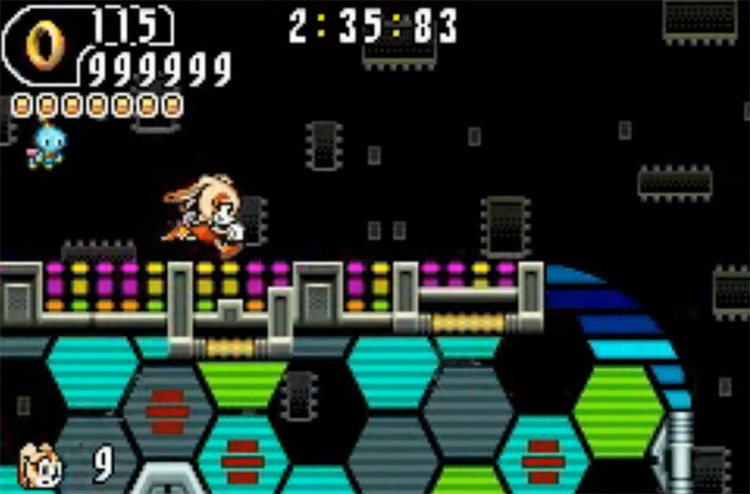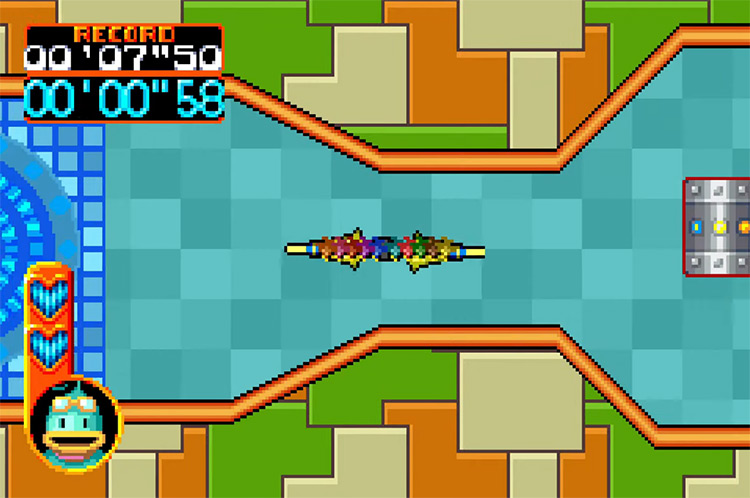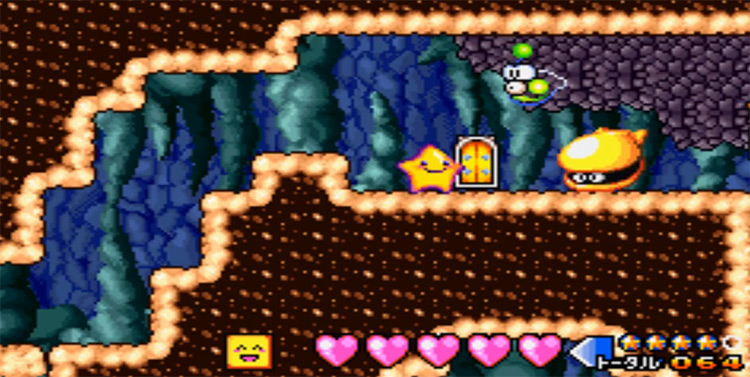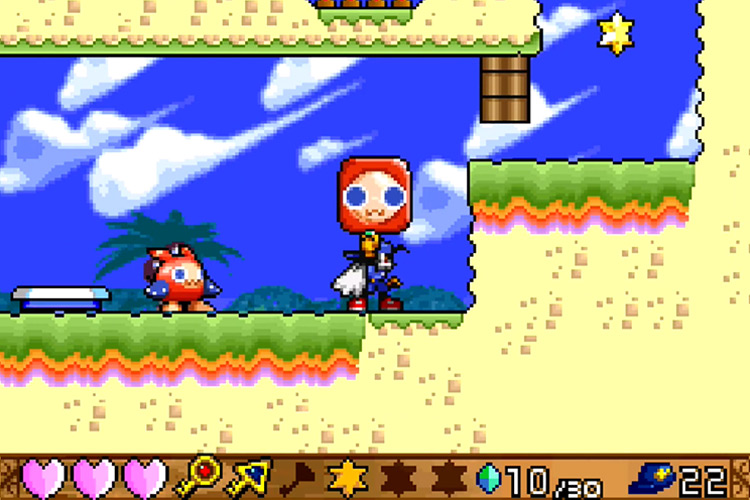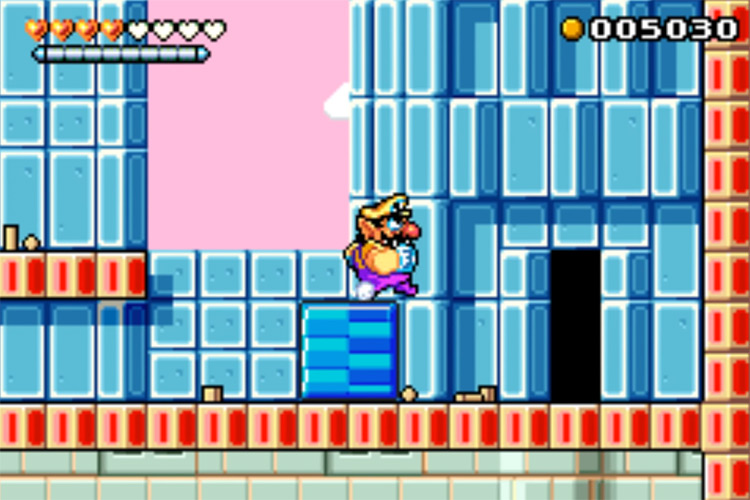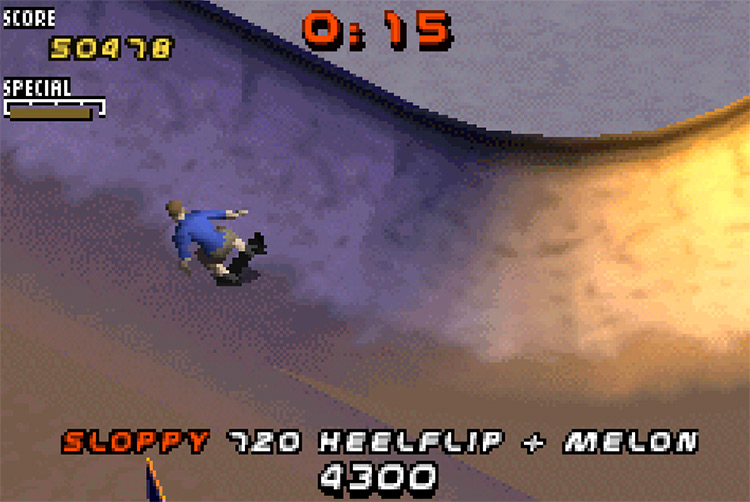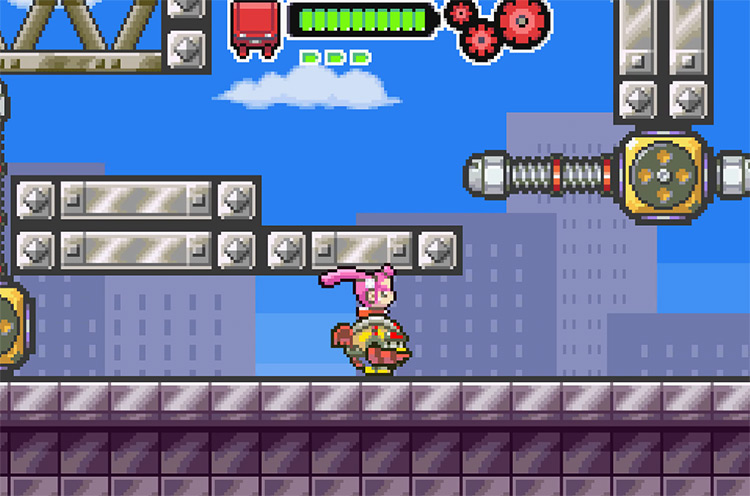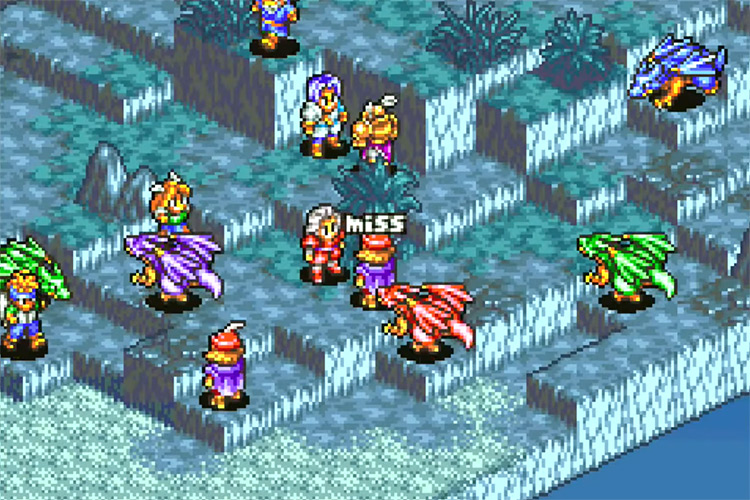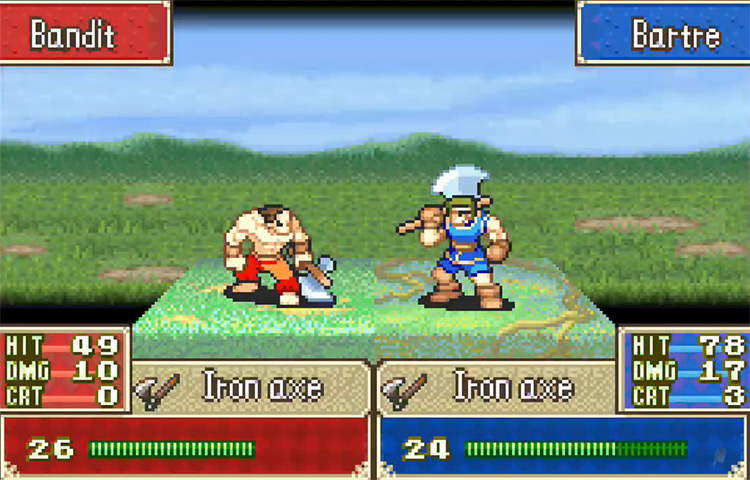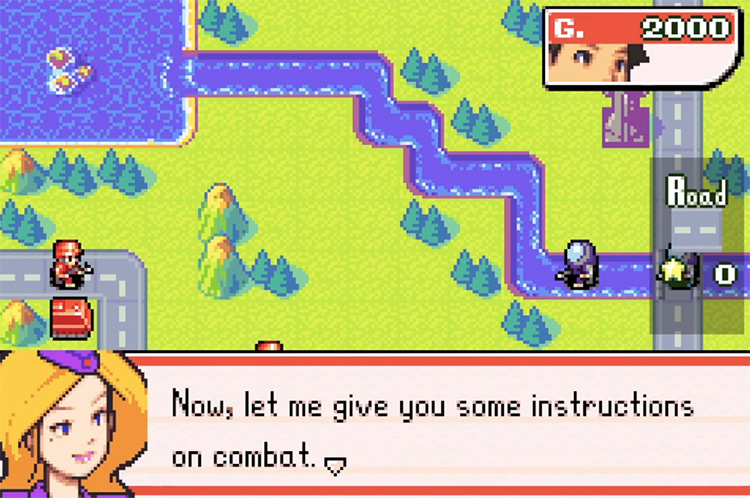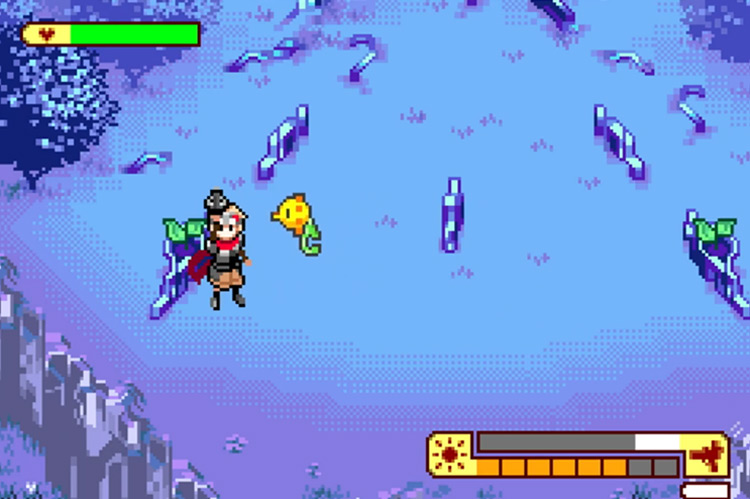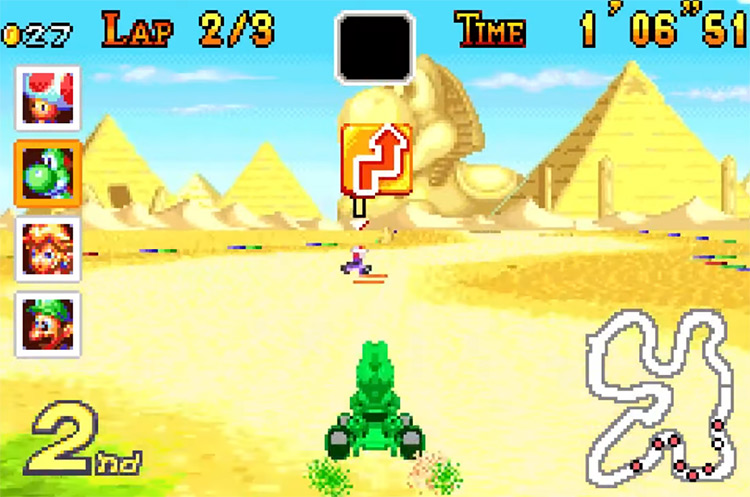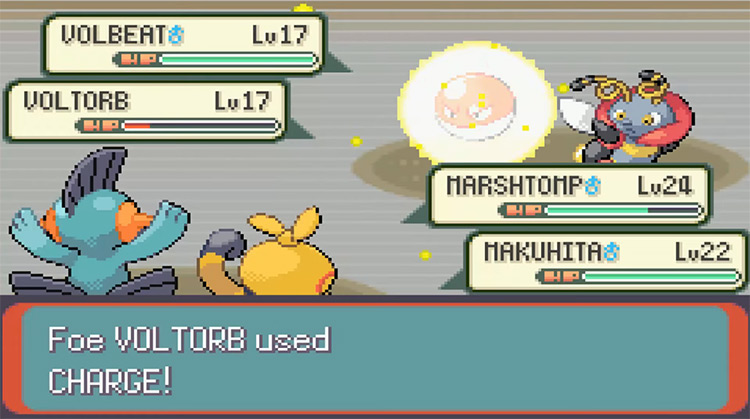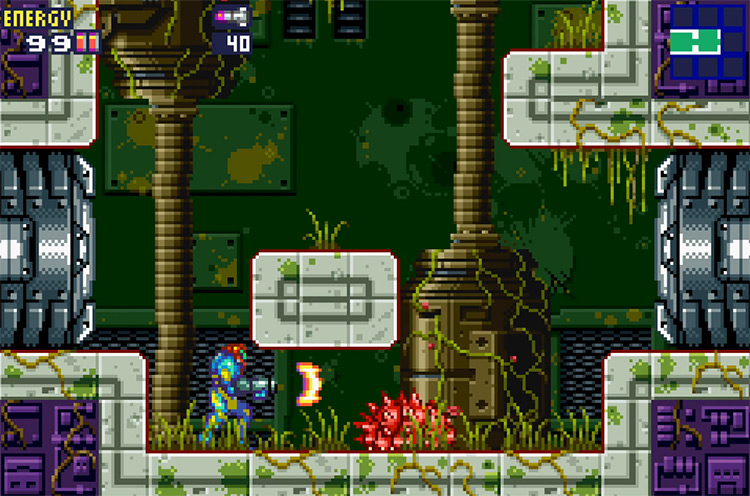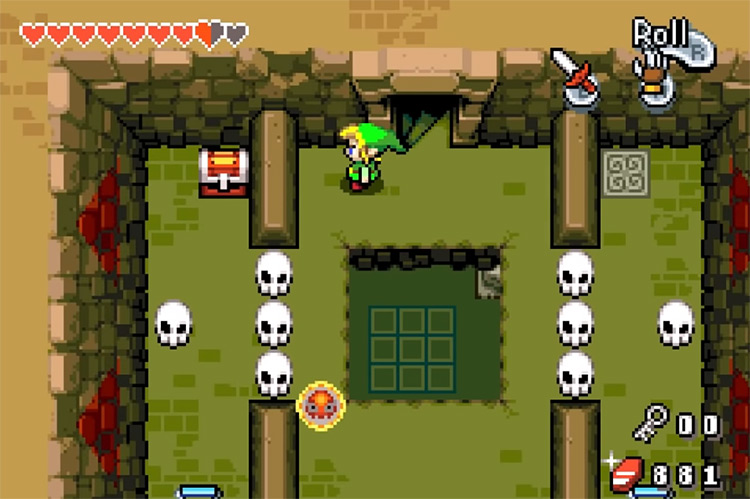Everyone wanted a piece of the pie, so game developers gave Nintendo’s 32-bit handheld a lot of love. The GBA’s game library is full of unmissable exclusives, but there are definitely some highlights. These system sellers got the GBA to over 80 million units sold, and they’re still some of the biggest reasons to keep your handheld running in the 2020s!
15. Sonic Advance 2 (2003)
Sonic Advance 2 was one of the first classic 2D Sonic platformers I ever played, and it gave me extremely high standards for the Sonic franchise. Thanks to creative level design and gameplay that focuses on speed rather than combat, Sonic Advance 2 delivers a unique experience that lives up to the classics. These gameplay elements would become the basis for the franchise’s future – at least on the 2D platformer front. We’d see them return in full force for Sonic Rush (2005) on the Nintendo DS.
14. Kuru Kuru Kururin (2001)
We’ve all experienced the simple fun of trying to spin a pencil between our fingers. If you managed to master the art of pencil-spinning, playing Kuru Kuru Kururin is the logical next step. This unusual puzzle game lets you control a magical spinning baton known as the “Helirin,” which you’ll navigate through increasingly complex mazes. Regrettably, Kuru Kuru Kururin never made it to the US, but an English localization was released in PAL regions.
13. Densetsu no Stafy (JP) (2002)
If this was “Top 10 Lost Business Opportunities in Gaming”, not releasing Densetsu no Stafy in the US would be somewhere around the top. This cutesy platformer follows an adorable star-shaped hero who goes around helping his underwater friends. It could be classified as an “amphibian platformer,” as walking on dry land and swimming underwater are equally important. According to insider info, they didn’t even try to get it localized back then because of an abundance of Japanese cultural references that wouldn’t make sense to Westerners. Let’s be real here. Nobody understands what’s going on in the Kirby franchise – but the gameplay is good, and the protagonist is adorable. Instant money printer! This could have been a childhood-defining hit.
12. Klonoa: Empire of Dreams (2001)
Klonoa: Door to Phantomile (1997) was one of the most magical experiences of my early childhood, and Klonoa: Empire of Dreams let me take the magic with me on the go. Despite its 3D graphics, the original Klonoa was a regular side-scroller platformer, so its gameplay translated well to sprite-based 2D graphics. Grabbing enemies with your Wind Bullet and using them to jump higher or launching them to activate switches feels just as good on the GBA as it did on the PlayStation. The graphics are also bright and colorful, with boldly outlined sprites that give it a cel-shaded look.
11. Wario Land 4 (2001)
The fourth entry in Wario’s platforming franchise is by far the best. It follows Wario as he challenges the dangers of an ancient temple, exploring hazardous passages to gather four treasures and free Princess Shokora. The platforming levels feature excellent design, with plenty of challenges and puzzles. Boss fights are also a definite highlight, thanks to the wacky and bizarre boss design. That said, the game really gets interesting after the boss battles. Wario has to run back to the entrance of each passage as it collapses behind him, creating some of the most high-adrenaline gameplay on the GBA.
10. Tony Hawk’s Pro Skater 2 (2001)
Anyone who’s even a little video game savvy knows not to expect much from the portable version of a big home-console game. Nowadays, consoles like the Nintendo Switch can do it all – but you couldn’t expect your Game Boy Advance to compete with a PlayStation in the 2000s. That is unless we’re talking about Tony Hawk’s Pro Skater 2 on the GBA. The people at Neversoft put their back into translating the excitement of sliding down a rail or landing epic tricks from 3D to isometric 2D. The results were superb.
9. Drill Dozer (2006)
Game Freak was essential in ensuring the GBA’s success. They developed many Pokémon games for the console, including Pokémon Ruby & Sapphire (2002) and Pokémon FireRed & LeafGreen (2004), all massive successes. But there’s another Game Freak title you can’t overlook on the GBA. Drill Dozer is an unusual action platformer where you play as a little girl in a badass drilling robot. It’s basically Tengen Toppa Gurren Lagann, but with a cutesy aesthetic. The creative gameplay and beautiful graphics were already remarkable, but it’s the rumble-pak on the cartridge that makes Drill Dozer unforgettable. Expect this to burn through your batteries in half the time.
8. Tactics Ogre: The Knight of Lodis (2002)
Strategy RPG and portable consoles are a match made in heaven – and playing Tactics Ogre on the go is heaven itself. Quest Corporation did a fantastic job bringing the intricate field-and-class combat system to the GBA. Even though the graphics and the complexity of the job system had to be slightly toned down, The Knight of Lodis retains the same narrative style, mythos, and gameplay that made the series famous in the first place. Final Fantasy Tactics Advance (2003) is also a must-play on the GBA, but if you’re looking for a real challenge and a genuinely good story, Tactics Ogre is the way to go.
7. Fire Emblem: The Blazing Blade (2003)
The first Fire Emblem released in English was a turning point in the history of strategic RPGs in the West – and you needed a GBA to be a part of it. Years of perfecting the formula since FE: Shadow Dragon (1990) came out in Japan allowed Intelligent Systems to enter the Western market with a polished product. It features everything that makes Fire Emblem special: a brutal campaign, perma-death, and unforgettable characters, including the main characters Lyn, Eliwood, and Hector. The rather complex storyline, full of moral dilemmas, war politics, and scheming, felt mature but exciting, allowing FE to draw in new fans from a wide age range.
6. Advance Wars 2: Black Hole Rising (2003)
Advance Wars is similar to Fire Emblem. You command your forces on a grid-based map, trying to capture strategic positions until routing the enemy. The biggest difference – other than the modern setting – is that your army isn’t made up of named characters. Advance Wars follows a group of Commanding Officers, each with a unique skill to share with their forces on the ground. These forces include infantry, artillery, bombers, and other modern military units. While the original Advance Wars (2001) is a must-play, AW2: Black Hole Rising has much more content, including all-new Commander Officers.
5. Boktai: The Sun Is in Your Hand (2003)
In all my years as a gamer, I’ve yet to find a better gimmick than Boktai’s Gun del Sol. The Gun del Sol – or Solar Gun – is Django’s main weapon against the vampire menace. It concentrates power from the sun and releases it for massive damage against the undead. When I say it charges with the sun, I mean the GBA cartridge has a tiny photosensitive detector that’ll charge your gun as you stand under the sun in real life. It’s something that could only have been done on the Game Boy Advance. It ends up being more trouble than it’s worth, but it’s still one of the most memorable experiences on the handheld.
4. Mario Kart: Super Circuit (2001)
You can’t go wrong with Mario Kart – and Super Circuit is no exception. Maybe it lacks the gorgeous graphics of Mario Kart 8 Deluxe (2014), but gameplay feels tight, and races are just as exciting. Along with several all-new tracks, Super Circuit lets you go back and play every circuit from the original Super Mario Kart (1992). And you’re telling me I get all of this on the go? Get out of here! This is simply one of the cornerstones of a well-rounded GBA game collection.
3. Pokémon Emerald (2005)
Pokémon Ruby & Sapphire had already made waves with their gorgeous graphics, awesome pocket monster designs, and coastal region of Hoenn. Emerald took it to the next level by introducing the Battle Frontier – a lengthy final challenge after the player conquers the Pokémon League. HMs like Surf, Dive, and Waterfall are your best friends when traversing Hoenn. This can be a little annoying sometimes, but the sense of exploration and discovery you get from this region is second to none. Plus, this generation has the absolute best starters. Torchic is the cutest thing!
2. Metroid Fusion (2002)
The release of Metroid Dread (2021) on the Nintendo Switch has me looking back on the franchise’s history and how big of a role the GBA played in shaping what it is today. Games like Metroid: Zero Mission (2004) and Metroid Fusion kept the classic side-scrolling gameplay alive by updating and streamlining it to resemble the Metroid Prime series on the GameCube. While I consider Zero Mission a must-play for fans of the franchise, Metroid Fusion should be your choice if you could only play one. Its tight gameplay, excellent graphics, and absorbing storyline helped convince players that this was the right direction for Metroid – and its impact is easy to see on Metroid Dread.
1. The Legend of Zelda: The Minish Cap (2005)
I’m a big fan of the post-Wind Waker era of the Legend of Zelda franchise. People back then were up in arms about the new cartoonish art style, calling it too “kiddie” and immature. Luckily, I was a kid in the early 2000s, so the change was a big win in my eyes. The Wind Waker’s cel-shaded graphics made it one of the prettiest games on the GameCube – and this focus on bright and colorful graphics translated just as well into the 2D realm. It might look different, but The Minish Cap on the GBA is just as good if not better than previous 2D Zeldas like Oracle of Ages/Seasons (2001) and A Link to the Past (1991).
